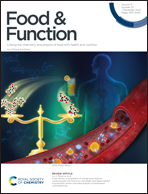An oral hydrogel carrier for delivering resveratrol into intestine-specific target released with high encapsulation efficiency and loading capacity based on structure-selected alginate and pectin†
Abstract
Resveratrol (RES) has many beneficial effects on the human body, but it is always unstable, resulting in low oral bioavailability, especially in the gastrointestinal tract. In this study, we developed an oral intestine-specific released hydrogel carrier for targeted RES release in the intestinal tract, which was composed of alginate (ALG) with a specific ratio of α-L-guluronic (G blocks) and β-D-mannuronic (M blocks) and low methoxyl pectin (LMP). The encapsulation efficiency and loading capacity of RES was 92.04 ± 0.32% and 6.41 ± 0.022 mg g−1 samples, respectively. Positioning release kinetics were investigated in vivo and in vitro. Also, this hydrogel carrier provides good protection for RES against the stomach. 94.71% of RES could be transported to the intestines in two hours after oral administration and released mainly in the small intestine and colon. Thus, the hydrogel carrier is conducive to RES, which is absorbed through the intestinal barrier rather than the stomach after oral administration. Moreover, the hydrogel carrier could load other health factors with expected encapsulation efficiencies, such as curcumin (93.52%), ascorbic acid (90.33%), ginsenoside Rg3 (81.54%), and EGCG (92.27%). These also implied that the hydrogel carrier holds general applicability in disease management.

- This article is part of the themed collection: Food & Function HOT Articles 2022


 Please wait while we load your content...
Please wait while we load your content...